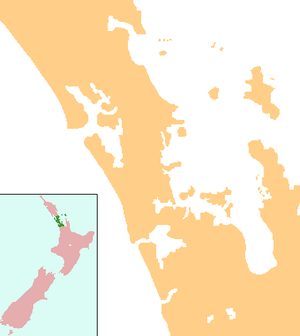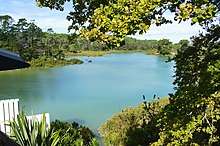Riverhead, New Zealand
Riverhead is a small, historically predominantly working-class town located at the head of the Waitematā Harbour in the north-west of Auckland, New Zealand. The region around Riverhead and the neighbouring towns of Kumeu and Huapai is known for its vineyards. This town has had its 15 minutes in the spotlight appearing in movies Bridge to Teribithia[2] and Crooked Earth and the odd television show such as Outrageous Fortune.
Riverhead | |
|---|---|
 Riverhead | |
| Coordinates: 36°45′31″S 174°35′32″E | |
| Country | |
| Region | Auckland |
| Territorial authority | Auckland Council |
| Ward | Rodney |
| Population (June 2019)[1] | |
| • Total | 2,010 |
| Postcode | 0820 |

Riverhead was briefly a railway terminus in the 19th century, located at the eastern end of the isolated Kumeu-Riverhead Section. The line operated from 1875 to 1881 as a link from Auckland to regions north, with Riverhead acting as the transition point from ferry to railway. When the North Auckland Line connected Kumeu with Auckland via rail in 1881, the coastal shipping became unnecessary, and with no reason to continue operating, the railway to Riverhead was closed.
The region features a pine plantation forest that is popular with horse riders, mountain bikers and motorcyclists. Riverhead Forest is operated by Matariki Forests, under Crown Licence. The forest was originally planted on poor kauri gum fields.[3]
Governance
Riverhead is part of the Local Government Rodney Ward of Auckland Council and is part of the Kumeu Subdivision of the Rodney Local Board.
Riverhead is in the Helensville Electorate however proposed boundary changes in late 2019 could change this.
Demographics
| Year | Pop. | ±% p.a. |
|---|---|---|
| 2006 | 1,305 | — |
| 2013 | 1,362 | +0.61% |
| 2018 | 2,802 | +15.52% |
| Source: [4] | ||

Riverhead had a population of 2,802 at the 2018 New Zealand census, an increase of 1,440 people (105.7%) since the 2013 census, and an increase of 1,497 people (114.7%) since the 2006 census. There were 864 households. There were 1,422 males and 1,380 females, giving a sex ratio of 1.03 males per female. The median age was 35.2 years, with 699 people (24.9%) aged under 15 years, 450 (16.1%) aged 15 to 29, 1,437 (51.3%) aged 30 to 64, and 219 (7.8%) aged 65 or older.
Ethnicities were 86.3% European/Pākehā, 10.1% Māori, 3.4% Pacific peoples, 9.1% Asian, and 2.6% other ethnicities (totals add to more than 100% since people could identify with multiple ethnicities).
The proportion of people born overseas was 24.6%, compared with 27.1% nationally.
Although some people objected to giving their religion, 61.3% had no religion, 28.4% were Christian, and 4.3% had other religions.
Of those at least 15 years old, 603 (28.7%) people had a bachelor or higher degree, and 225 (10.7%) people had no formal qualifications. The median income was $52,600. The employment status of those at least 15 was that 1,299 (61.8%) people were employed full-time, 321 (15.3%) were part-time, and 48 (2.3%) were unemployed.[4]
Education
Riverhead School is a coeducational full primary (years 1-8) school with a roll of 447 students as at March 2020.[5][6] The school was built in 1872, and substantially rebuilt in 1960.[7] In 2010 six new classrooms, a resource room and a library were added.
Notes
- "Subnational Population Estimates: At 30 June 2019". Statistics New Zealand. 22 October 2019. Retrieved 11 January 2020.
- Filming locations for Bridge to Terabithia
- Matariki Forests
- "Statistical area 1 dataset for 2018 Census". Statistics New Zealand. March 2020. Riverhead (115900). 2018 Census place summary: Riverhead
- "New Zealand Schools Directory". New Zealand Ministry of Education. Retrieved 26 April 2020.
- Education Counts: Riverhead School
- "HISTORY - Riverhead School". Riverhead School. Retrieved 8 December 2010.